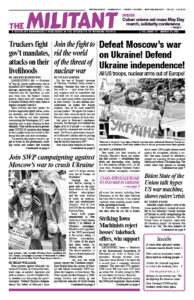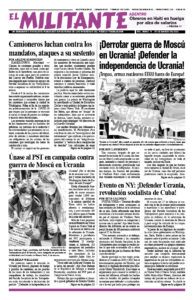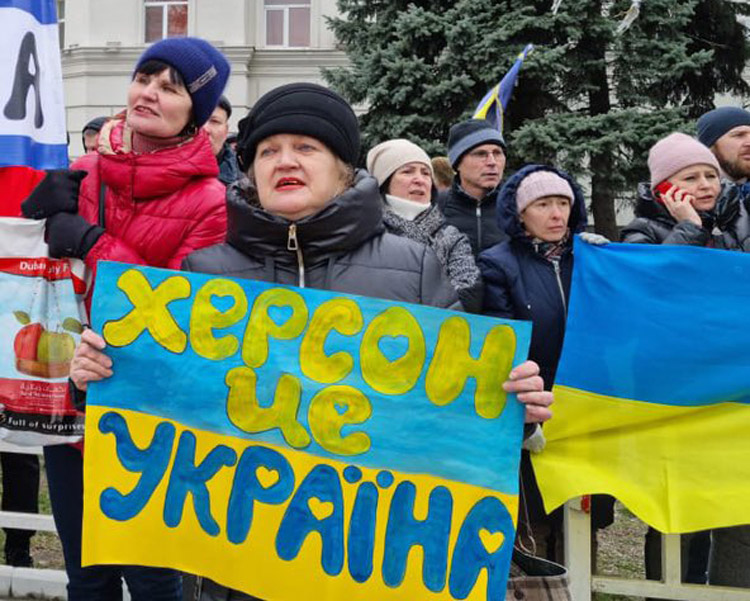Two weeks into their invasion of Ukraine, Moscow’s forces are widening their assaults — slaughtering hundreds and devastating cities, leading to a fast-growing refugee crisis. At the same time, President Vladimir Putin’s forces confront courageous resistance all across the country, including from Ukrainians in the few cities Moscow has been able to occupy. It has inspired solidarity from working people worldwide, including in Russia.
In Kherson, in southern Ukraine, two days after the city fell to Putin’s forces some 2,000 people demonstrated against the occupation, defying a curfew. One man, cheered by onlookers, jumped on a passing Russian armored vehicle and waved a Ukrainian flag. The crowd stood their ground as Russian soldiers fired into the air to try to scare them away.
In nearby Nova Kakhovka, Russian forces opened fire on an anti-occupation protest of 2,000, injuring at least five.
Days after invading forces seized the mostly Russian-speaking city Melitopol, thousands of residents protested the occupation, waving Ukrainian flags and chanting at Russian soldiers, “Go home! Go home!” Despite a ban on demonstrations, protests have been held there daily since and are growing in size. Residents approach Russian soldiers and ask them what they are doing in Melitopol and challenge Putin’s pretexts for his military invasion.
“The Socialist Workers Party hails their resistance and calls for the defeat of Putin’s invading forces,” Socialist Workers Party National Secretary Jack Barnes said in a March 3 public statement on behalf of the party’s National Committee. It is available on the Militant website.
Protests in Russia against the war
At a March 5 rally in New York, Sasha Nazintseva, 28, held a sign indicating she was Russian and opposed Putin’s war. Her family is in Russia and she told the Militant many Russians are against the invasion, but were “intimidated from protesting by Putin’s new laws.” Penalties include up to 15 years’ imprisonment for spreading “fake news” about the war.
“But things are escalating very quickly,” she said.
Chanting “No to war!” tens of thousands rallied in 147 cities across Russia the next day. More than 5,000 people were detained and many beaten. Since the invasion almost 13,500 protesters have been arrested. Some 12,000 Russian health care workers signed a letter to Putin calling for an end to the war.
A March 6 video shows Sergei Tsivilev, the pro-Putin governor of southwest Siberia’s Kuzbass region, confronted by an angry crowd of soldiers’ mothers. He urged the women not to criticize until the war “ends, which it will soon.”
A woman retorted, “When everyone dies!”
“Why did they send our boys there?” a woman can be heard asking Tsivilev. “They were sent as cannon fodder,” one responds, while another says authorities “lied to everyone.”
Moscow’s invading troops are mainly conscripts and disproportionately from rural areas of Russia or non-Russian.
Putin threatened March 3 that his artillery and missile bombardment of urban areas would “get worse if the Ukrainians do not accept surrender terms.” He demands recognition of the Kremlin’s 2014 seizure of the Crimean Peninsula and areas in eastern Ukraine that were captured by pro-Moscow separatist groups.
Kyiv and Kharkiv, the two largest Ukrainian cities, have been besieged by Moscow with indiscriminate shelling since ground assaults failed to lead to their rapid capture. People in Kharkiv, Mariupol and elsewhere are hiding in underground shelters, without heating, water or electricity, as Ukrainian forces hold Russian troops off. Food and medicines are running out.
Mariupol is a special target since Ukrainian government forces defeated an attempted takeover by pro-Moscow separatists there in 2014, following the popular Maidan uprising that toppled the pro-Moscow regime of President Viktor Yanukovych.
By March 9 over 2 million people, mainly women, babies and children as well as the elderly, had fled Ukraine across its western and southern borders. Of these, 1.2 million have crossed into Poland.
“But there are no border refugee camps because families are taking people in,” Zofia Lipton, a Polish American, told the Militant at the New York rally March 5. Her mother told her that “in the streets of Warsaw, you hear more and more Russian spoken,” the common language that many Poles and Ukrainians use to talk with each other.
No-fly zone?
Ukrainian President Volodymyr Zelensky’s call for Washington to impose a “no-fly zone” over Ukraine was echoed by some at solidarity rallies in cities in the U.S. and elsewhere. The administration of President Joseph Biden says it will not do so.
No-fly zones were imposed by the U.S. rulers and allied air forces in the 1990s over Iraq just after the first Iraq war. The intervention was used by Washington to unleash deadly assaults, weaken the Saddam Hussein regime’s air defenses, and pave the way for the second Iraq war in 2003.
Putin warned that he would view any acts by governments to police such a zone as “participation in the armed conflict.”
Expanding sanctions targeting Russia by Washington and other imperialist powers have been reinforced by a ban on Russian energy imports imposed by both Washington and London March 8. In reality these measures hit working people in Russia, already facing years of worsening conditions of life and work, complicating efforts to mobilize opposition there to Moscow’s war.
“The Socialist Workers Party opposes the broadly aimed economic and financial embargo imposed on Russia by the U.S., European, and other imperialist ruling classes, as well as military maneuvers by these governments,” the SWP statement explains.


